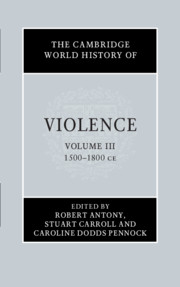Book contents
- The Cambridge World History of Violence
- The Cambridge World History of Violence
- The Cambridge World History of Violence
- Copyright page
- Contents
- Figures
- Maps
- Contributors to Volume iii
- Introduction to Volume iii
- Part I Empire, Race and Ethnicity
- Part II Cultures of War and Violence
- Part III Intimate and Gendered Violence
- 11 Legal Understandings of Sexual and Domestic Violence in Late Imperial China
- 12 Samurai, Masculinity and Violence in Japan
- 13 Gender and Violence in Early America
- 14 Sexual and Family Violence in Europe
- 15 Men Fighting Men: Europe from a Global Perspective
- 16 Suicide in the Early Modern World
- Part IV The State, Punishment and Justice
- Part V Popular Protest and Resistance
- Part VI Religious and Sacred Violence
- Part VII Representations and Constructions of Violence
- Index
- References
12 - Samurai, Masculinity and Violence in Japan
from Part III - Intimate and Gendered Violence
Published online by Cambridge University Press: 13 March 2020
- The Cambridge World History of Violence
- The Cambridge World History of Violence
- The Cambridge World History of Violence
- Copyright page
- Contents
- Figures
- Maps
- Contributors to Volume iii
- Introduction to Volume iii
- Part I Empire, Race and Ethnicity
- Part II Cultures of War and Violence
- Part III Intimate and Gendered Violence
- 11 Legal Understandings of Sexual and Domestic Violence in Late Imperial China
- 12 Samurai, Masculinity and Violence in Japan
- 13 Gender and Violence in Early America
- 14 Sexual and Family Violence in Europe
- 15 Men Fighting Men: Europe from a Global Perspective
- 16 Suicide in the Early Modern World
- Part IV The State, Punishment and Justice
- Part V Popular Protest and Resistance
- Part VI Religious and Sacred Violence
- Part VII Representations and Constructions of Violence
- Index
- References
Summary
In the period 1600–1868 Japan shifted from incessant civil war of the Warring States period (1467–1600) to an era of extended peace that lasted more than two centuries. This early modern experience, defined as it was by the absence of warfare, is quite remarkable in world history. It was a peace, however, imposed by a large-scale military aristocracy, the samurai (6–7 per cent of the population), who disarmed other social groups (commoners) below them in the social hierarchy and forbade them from carrying weapons. Although this created a type of garrison state, samurai were constrained legally in their ability to freely use their weapons, a long and a short sword. Moreover, the extended period of peace resulted in two currents of tension related to samurai identity: a dynamic tension between the civil arts, or the arts of peace (bun) and the military arts (bu); and a tension that arose from the lack of opportunity for samurai to demonstrate their martial skills and valour on the battlefield, resulting in a hypersensitivity in defending their honour. This chapter explores how a culture of honour violence developed among male samurai during the centuries of the Tokugawa peace and considers its importance in the construction of samurai masculinity.
Keywords
- Type
- Chapter
- Information
- The Cambridge World History of Violence , pp. 236 - 254Publisher: Cambridge University PressPrint publication year: 2020

